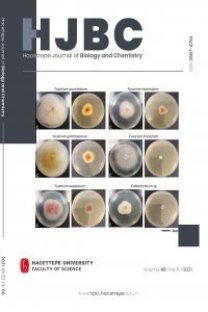Son İnstar Bombyx mori Testislerine Juvenil Hormon Analoğu Fenoxycarb’ın Etkileri
The Effects of Juvenile Hormone Analogue, Fenoxycarb on the Last Instar Testes of Bombyx mori
___
- G.J.P. Singh, Hemolymph carbohydrate and lipid mobilization in Locusta migratoria in relation to the progress of poisoning following bioresmethrin treatment, Pest. Biochem. Phys., 25 (1986) 264–269.
- K. Fotouhi, M.M. Fazel, A. Kavousi, Effects of pyriproxyfen on bioenergetic resources of Leptinotarsa decemlineata (Say) (Coleoptera: Chrysomelidae), Türk. Entomol. Derg., 39 (2015) 11–22.
- M.L.M. Garcia, R.P. Mello, B.C.M. Mello, Effect of Precocene II, Ecdysone and juvenile hormone on the glycogen concentration in pupae of Stomoxys calcitrans (Dipter Muscidae), Mem. Inst. Oswalda Cruz, 83 (1988) 451–454.
- D. Mandal, D.K. Chaudhuri, Studies on carbohydrate, protein and lipid levels in normal and stress conditions in fat body and integument as compared to whole body during development of rice moth, Corcyra cephalonica (ST), Insect Sci. Applic., 13 (1992) 121–128.
- R. Pant, S. Kumar, Metabolic fate of carbohydrates and lipids during moulting of Philosamia ricini (Lepidoptera: Saturnidae), Insect Biochem., 9 (1979) 577-582.
- O. Parlak, S. Sakurai, M. Kaya, T. Ohtaki, Content and possible role of ecdysterids in the larval ovary of the silkworm, Bombyx mori, Invertebrate Reprod. Develop., 21 (1992) 1-6.
- M.G. Leonardi, S. Cappellozza, L. Cappellozza, P. Lanne, P. Parentis, B. Giordana, Effects of the topical application of an insect growth regulator (fenoxycarb) on some physiological parameters in the fifth instar larvae of the silkworm Bombyx mori, Comp. Biochem. Physiol., 113 (1996) 361-365.
- E. Van Handel, Rapid determination of glycogen and sugars in mosquitoes, J. Am. Mosq. Control Assoc., 1 (1985) 199-301.
- S.G. Dedos, H. Fugo, Induction of dauer larvae by application of fenoxycarb early in the 5th instar of the silkworm, Bombyx mori, J. Insect Physiol., 45 (1999) 769-775.
- A. Öber, Zoolojide Laboratuvar Teknikleri, 3. Baskı, Ege Üniversitesi Basımevi Bornova İzmir, No: 183 (2009) 209s. ISBN 978-975-483-824-4.
- M. Kamimura, Effects of a juvenile hormone analogue, fenoxycarb, on larval growth of the silkworm, Bombyx mori (Lepidoptera: Bombycidae), JSAEZ, 30 (1995) 487-489.
- J.K. Presnell, M.P. Schreibman, Humason’s animal tissue techniques, 5th edition, The Johns Hopkins University Press (1997) 572p, ISBN 0-8018-5401-6.
- M. Kamimura, M. Kiuchi, Effects of a juvenile hormone analog, fenoxycarb, on 5th stadium larvae of the silkworm, Bomyx mori (Lepidoptera:Bombycidae), Appl. Ent Zool., 33 (1998) 333-338.
- G. Turgay İzzetoğlu, A. Öber, Total proteolytic activity on the pupal rectal sac of Bombyx mori L. (Lepidoptera: Bombycidae), Hacettepe J. Bio. Chem., 41 (2013) 67-72.
- J.L. Nation, Insect physiology and biochemistry, 2nd edit., Department of Entomology and Nematology University of Florida, U.S.A (2008) 500 p, ISBN 978- 1-4200-6177-2.
- G. Turgay İzzetoğlu, A. Öber, Histological investigation of the rectal sac in Bombyx mori L., Turk J Zool., 35 (2011) 213-221.
- 4. N. Kılınçer, Ş. Bayram, Böceklerde üreme sistemleri, Ankara Üniversitesi, Ziraat Fakültesi, Bitki Koruma Bölümü (1999) 59s.
- E. Göncü, O. Parlak, The influence of juvenile hormone analogue, fenoxycarb on the midgut remodeling in Bombyx mori (L., 1758) (Lepidoptera: Bombycidae) during larval-pupal metamorphosis, Turkish J. Ent., 35 (2011) 179-194.
- J. Devillers, Juvenile hormones and juvenoids, 3rd edit., CTIS-centre de traitement de l’information scientifique rillieux la pape, France (2013) 410 p, ISBN 978-1-4665-1322.
- C. Gillott, Entomology, 3rd edit., University of Saskatchewan Saskatoon, Saskatchewan, Canada (2005) 831 p.
- B. Yılmaz, Omurgasızlarda hormonlar, Ankara Üniv. Vet. Fak. Derg., 35 (1988) 218-226.
- M.J. Klowden, In physiological systems in insects, Chapter 4 – Reproductive Systems, 2. edit, University of Idaho, Moscow Idaho (2008) 181-238.
- E. Batır, E. Göncü, and O. Parlak, Ecdysone receptor B1 in Bombyx mori L. (Lepidoptera:Bombycidae) prothoracic gland under various organ culture conditions, IUFS J. Bio., 71 (2012) 31-42.
- O. Parlak, İpekböceği Biyolojisi, Ege Üniversitesi Basımevi, İzmir, No: 171 (2001) 127s ISBN 975-483- 485-7.
- ISSN: 2687-475X
- Yayın Aralığı: 4
- Başlangıç: 1972
- Yayıncı: Hacettepe Üniversitesi, Fen Fakültesi
Necla PEHLİVAN, Sengul Alpay KARAOGLU, Arif BOZDEVECİ
Nilüfer AKSÖZ, Demet ERDÖNMEZ, Kübra ERKAN TÜRKMEN
Etkili Peroksidaz Taklitçi Olarak Çok Tabakalı Grafen Oksit-Gümüş Nanopartikül Nanoyapısı
Burak DERKUS, Pinar ACAR BOZKURT
Yeni İzole Ediilmiş Trichoderma Citrinoviride’den Lipaz Üretiminin Saptanması
Nilüfer CİHANGİR, Muhammed Hasan AKYIL
